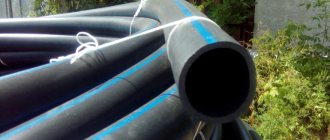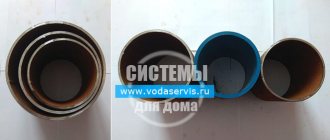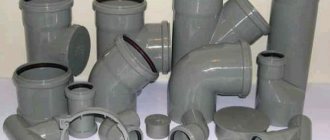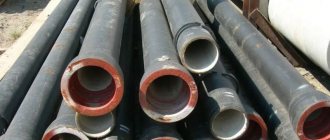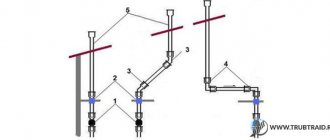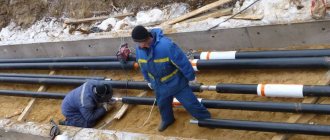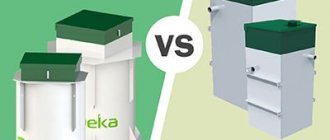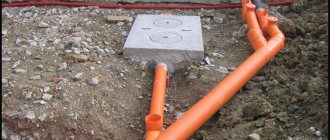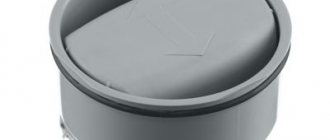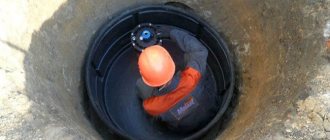When planning to organize an independent water supply at home, it is necessary to study the technology and nuances of creating a well. One of the key points in arranging an autonomous water supply system is the choice of casing.
The well shaft performs diverse tasks and largely determines the durability and uninterrupted operation of an autonomous water supply system. Agree, having invested a lot of money and effort into the construction of a well, the last thing you want to do is eliminate problems associated with poor quality of water intake.
Therefore, at the design stage, it is necessary to approach the choice of casing string with all responsibility. We will tell you which pipes are best for a well, what material and type of connection of trunk segments is preferable to use in a given situation. The knowledge gained will save you from purchasing the wrong product.
Purpose, features and requirements for casing columns
Tasks of the casing:
- Protection of well walls from collapse;
- Ensuring the integrity of the structure under ground pressure and displacement of soil layers;
- Prevents the penetration of surface groundwater and wastewater into the water intake part;
- Helps not to silt;
- When a well is cased with one pipe, it acts as a production string and contains a column of water.
The entire life of a water intake well is primarily affected by the quality of the casing pipes:
- High-quality material, its strength and resistance to deformation during the entire period of use;
- 100% sealing of walls and pipe connections;
- The pipe material should not affect the chemical composition of groundwater;
- Non-corrosive to chemical elements.
One-piece pipe contacts for welding
The use of compounds with a high degree of rigidity is typical. Users have the following arguments for abandoning welding:
- Seam with insufficient corrosion protection.
- Installation of the column is difficult due to the fact that it can deviate from its axis.
- Welding seam with a low level of tightness.
But the listed defects can be easily avoided if you invite a welder with sufficiently high qualifications. The use of professional equipment is mandatory. Due to the need to take such measures, the cost of work increases. Therefore, drilling a well will cost more.
Selection of casing pipes by parameters
There is no single correct well design for drilling. For each specific area, the drilling engineer selects the design individually, taking into account many factors:
- The structure of the geological section of the soil at the drilling point;
- Aquifer and groundwater levels;
- Characteristics of the well pump;
- Depth and diameter of well drilling.
To make a decision, it is necessary to take into account the important parameters of casing pipes:
- Material.
The cost of implementing the project, whether repairs will be possible and the reliability of the structure depend on the material of the pipes. - Pipe connection option.
The connection of the pipes to each other is selected depending on the material of the column, to what depth the well is being drilled, and what diameter of the casing pipe is used. The connection must be airtight, because during use, groundwater and other impurities may enter the water. In this regard, the well pump may fail and the well itself will become unusable. - Diameter.
The optimal pipe diameter is calculated taking into account peak water consumption per day. A larger pipe diameter gives a higher well flow rate.
Pressure or non-pressure pipeline?
The only correct option is to use pressure pipes. Only such products can withstand double-sided pressure. From the outside, the walls of the column are affected by the buoyancy of the soil, and from the inside by water pressure.
The construction of a pressure main will protect the aquifer system from premature failure. When choosing a water pipe, compare its operating pressure with the expected flow rate of the well
The video reviews below will help you decide on the most optimal well casing option.
Types of materials and their characteristics
Metal casing pipes
Structures based on metal columns are the most reliable and have been proven over many years of use. Steel pipes with a diameter of 133-159 mm are installed in individual wells, but the wall thickness can be different. When choosing a drilling company and design, it is important to pay close attention to this. For a well to operate for more than 50 years, the pipe wall thickness must be at least 4.5 mm - photo 1.
Polymer pipes
PVC-U pipes.
Some drilling companies believe that metal pipes can be replaced entirely with pipes made of dense, unplasticized polyvinyl chloride. For many, to this day, this is a rather controversial issue. But still, since 2011, uPVC pipes have been used as the main casing - photo 2.
Disadvantages of uPVC pipes:
- Ground movements and interlayer pressure lead to column flattening, wells fail and cannot be repaired;
- The thread cannot withstand the load and, when twisted, cracks in the internal threaded connection. And such a connection becomes not airtight;
- Unplasticized polyvinyl chloride is prone to drying out and cracking over time, so there is no need to talk about reliability and durability;
- The caisson is attached to the uPVC casing through a clamping coupling, so the caisson often comes off, which complicates installation work.
PVC-U pipes have only one advantage - the pipes do not corrode.
At the Customer’s request, we can also use PVC-U pipes in our work in accordance with GOST P 51613-2000, but our engineers still recommend installing time-tested metal pipes.
HDPE pipes are low pressure polyethylene.
HDPE pipe is less durable; it is installed with an additional internal pipe in a two-pipe structure (metal + HDPE or uPVC + HDPE).
Rolled steel casing pipes
Advantages of rolled steel pipes:
- Structural strength (suitable for shallow and deep wells);
- Reliable assembly between each other;
- Steel does not emit harmful elements when in contact with water;
- High maintainability – high strength allows cleaning and additional drilling.
Galvanized casing pipes
When in contact with water and soil, the pipe walls are more resistant to corrosion. Galvanized pipes can be installed in a well for individual water supply. But such pipes are used less often than steel pipes due to the difference in price.
Stainless steel casing pipes
A stainless steel pipe has similar advantages to a rolled steel pipe, but has a very high cost. Stainless steel is not subject to corrosion and therefore lasts a very long time. It is almost not in demand due to the high price.
Well casing device
Let's assume that the well has been drilled. In this case, the hole must be perfectly level, otherwise the pump may break down, since it must hang in the well according to the principle of a plumb line. If the well offers the installation of both metal and plastic pipes, then the metal is installed first.
To do this, the hole must be widened towards the top, and it is drilled first in line. When installing metal, it is best to use threaded connections so that the metal in this place does not corrode in the future. Metal pipes are quite heavy, so it is best to hold them with special installations on drilling machines.
As for plastic, in the very first pipe, which will be located at great depths, it is worth equipping a filter by drilling many holes along the entire plane up to 1 m. You can use geotextiles for additional protection from dirt.
About 3 people should participate in the work. One person will hold, another will bring, the third will screw.
The pipe should be screwed in step by step, pre-lubricating the threaded connections with a special agent for reliable tightness.
The product should be lowered into the recess so that it does not reach the bottom of the well by about 1 meter. In this case, the water column must be significant. In the upper part, the plastic pipe is trimmed to the required size.
Next, pumping equipment is installed, which is fixed to a metal cable and lowered with a reserve of the water column. The hose from the pump passes through the well head, which, in turn, is fixed to a metal casing for the well. The head is screwed on with bolted connections or simply put on the casing, supporting it with its weight due to the load under the pump.
Casing connection options
- Seamless pipes with spiral or longitudinal welding seam.
They are used if the formation pressure is no more than 16 kg/cm2 and the temperature is less than 300 degrees. Service life 40-45 years. - Seamless pipes are called seamless pipes.
Produced using special high-tech machines. The cost of seamless pipes is 500 rubles more per 1 linear meter. The temperature and pressure characteristics are slightly greater than those of a seamed pipe.
Since there are no such temperatures and pressures in the underground environment, you can install seam pipes and not overpay for seamless ones.
Types of casing connections:
- On the thread.
The conical internal and external threads are connected to each other, the pipe fits into the pipe. - On the thread through the coupling.
There is an external conical thread on both ends, and an internal thread on the coupling. This connection is called reinforced. - Welding.
The quality and tightness of the seam depends on the professionalism of the welder.
Our experts advise choosing a conical connection, when the internal and external threads are connected to each other, the pipe fits into the pipe. Do not save money when choosing a welding connection, since the quality of the weld depends on the experience of the welding master, and the benefit is not great at all.
Calculation of water consumption during design
To select the pipe diameter and select the optimal pump power, you need to know the maximum water flow. For most households outside the city, all indicators have long been calculated and average statistical calculations are given. For example, if about 5 taps with water under pressure of 5 atmospheres are open in the house at the same time, then the pump capacity should be about 3 m3/hour. For these needs, a casing pipe with a diameter of 133 millimeters is usually selected. Calculations may show that the maximum water flow will be greater. In this case, you can use a well with a water yield of 4-8 m3/hour. Pipes with a diameter of 159 mm will be installed for this task.
All calculations must be made in such a way as to take into account the needs of the family for the future. For example, if you know that in 1-2 years there will be a new addition to the family and water consumption will increase, then make sure that a more efficient pump can be safely lowered into the casing pipe.
Table 2. Which casing pipe is better to choose for well reliability?
| Metal 133 mm (wall 4.5 mm) | Outside metal 133 mm (wall 4.5 mm + inside HDPE 117 mm wall 6.5 mm) | uPVC 125 mm (wall 8 mm) |
| Well guarantee | ||
| up to 10 years | up to 10 years | 5 years |
| Well life | ||
| 40 years | 50 years | 40 years |
| Cost of drilling with a large rig | ||
| 1800 rubles | 2100 rubles | 2100 rubles |
| Cost of using a well per year (60 meters deep)*, rub. | ||
| 2700 rubles | 2520 rubles | 3150 rubles |
Conclusions of drilling engineers based on many years of work experience:
- For many decades, the most reliable metal casing pipe has been in a two-pipe design (outer metal pipe with a conical connection + inside HDPE). This well design will last at least 50 years, since the additional plastic pipe is not subject to corrosion. Our warranty ranges from 3 to 10 years.
- If the goal is to save money, then it is possible to drill a well and install one 133 mm metal pipe. But this design is not applicable in all areas of the Moscow region (depending on the geological section and groundwater levels). The service life of such a well is on average 40 years.
- If you are a supporter of new technologies, then you can choose a design with a 125 mm PVC-U column. But such a well has its drawbacks: high cost, possible short service life, since it has not been tested by time.
The chief drilling engineer, with extensive experience, will recommend the optimal design option for your well over the phone, but it is always the project customer who makes the decision on the choice of casing pipes.
Determining the required pipe diameter
There are three types of aquifers: surface (or perched) at a depth of up to 15 m, on sand up to 30 m deep and in limestone layers. The surface horizon is suitable for digging wells, and it does not always contain high-quality drinking water. Sand wells are relatively cheap, but they are prone to siltation, which shortens their service life, and often have unstable water flow.
Limestone wells are the best source option, even taking into account the higher cost of drilling. They provide the highest water quality, flow rate and well life. The answer to the question of what pipe diameter to choose for a well depends on the dimensions, type and performance of the submersible pump, as well as the magnitude of the peak water demand.
The determining factor in choosing the diameter of the pipes is the dimensions of the well pump. Calculation of the pipe size suitable for it is carried out as follows:
- to the diameter of the pump casing in mm, add a minimum gap between the casing and the pipe walls of 4 mm, thereby obtaining the required internal diameter;
- Based on the result obtained and the available wall thickness options, select the appropriate pipe size.
For example, if you choose a pump with a casing diameter of 74 mm, then by adding a gap and a wall thickness of 5 mm, we get a result of 88 mm. This corresponds to pipes with an outer nominal diameter of 90 mm or thicker wall pipes of Ø 113 mm.
Note that only Grundfos produces reliable pumps of such a small diameter and they are very expensive. Therefore, to equip wells, submersible pumps in housings with a diameter of 100 mm are often chosen. They are much cheaper with an almost unlimited choice, but their installation requires pipes Ø 125 mm. When operating inexpensive vibration-type borehole pumps, you will need pipes with an outer diameter of 140 mm.
Fastening wells during drilling
- Well performance;
- Well lifespan;
- The strength and tightness of the channel through which the extracted product will flow from the horizon to the surface;
- Protection of the operating channel from corrosion;
- The strength of the well walls in places where the rocks are not stable enough;
- Tightness of separation of all permeable horizons from each other.
Securing oil wells involves the use of special columns or packers. The use of columns is the most popular method, which allows you to make the well strong, durable, and also isolate permeable horizons. Such columns are made up of special pipes called casing.
Water pipes made of stainless steel or with additional coating
Sometimes a controversial situation may arise as to which casing pipes for a well are better: metal pipe products with an additional anti-corrosion coating or made of stainless steel?
The solution to the issue is a simple truth: why pay more for stainless steel products if ferrous metal products have a service life that is almost equal to the operating period of the well.
In this situation, special attention should be paid to ferrous rolled metal with a galvanized surface. If such a coating is exposed to water for a long time, then the formation of zinc oxide can be observed on it. This substance poses a danger to human health. Therefore, galvanized pipes can only be used in wells for industrial water.
Which well is better made of plastic or metal?
At the end, we will summarize, especially for those who are too lazy to read all the material, we will immediately resolve the question of which casing pipe is better than HDPE or steel. Plastic is good and allows you to reduce the cost of drilling, it works great, but if protected by an iron pipe. A steel pipe is also good, but it is installed before the limestone, and the limestone itself must be lined with plastic. In our area (in the south of the Moscow region) it is impossible to leave limestone without casing. Therefore, the ideal combination is iron and plastic. If you don’t trust HDPE, you can overpay and make metal and metal.
Asbestos cement pipe products
Also, the casing can be equipped with asbestos-cement pipe products, and they can easily replace steel products with good material benefits. But asbestos cement has some special properties that should be taken into account when installing the casing.
Among the important characteristics of asbestos cement pipes are the following:
- The material meets environmental requirements and is neutral towards chemicals. These properties of the material indicate that during operation the possibility of harmful elements entering the water is eliminated.
- There is an opinion that asbestos has carcinogenic properties, but it has no justification. Yes, there may be fibers of the material in the water, but in small quantities, which can be easily removed using household water filtering devices.
- Asbestos cement is fragile, therefore, it requires caution during installation and operation. In addition, it is not recommended to carry out additional drilling of a finished well, the casing of which is made of asbestos cement.
- Asbestos-cement pipe products have fairly thick walls, which requires drilling larger wells to install such products.
- A pipe for the manufacture of which asbestos cement was used cannot be used as a filtration column in sand wells, therefore they are used only in artesian wells.
- The physical properties of the material allow the use of pipes in wells up to 100 meters.
